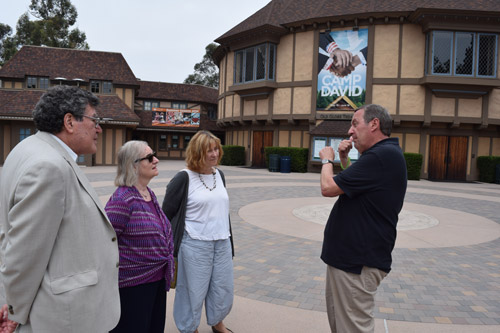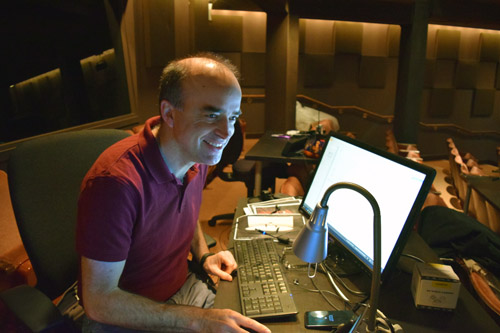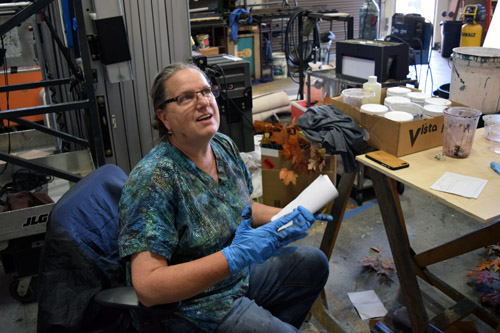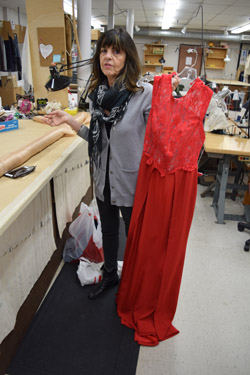
By Donald H. Harrison

SAN DIEGO – As luck would have it, our backstage tour of the Old Globe Theatre in San Diego’s Balboa Park came the day before the opening of Camp David, a play by Lawrence Wright which premiered in Washington D.C. and now has its second opening here, at one of America’s best known regional theaters.
Our guide, who was named by the Old Globe as “docent of the year,” Michael Robertson, told us that the Arena Stage in Washington D.C. and the Old Globe in San Diego “grouped together to do dual shows to save money.” The play depicting the 13 days of negotiations facilitated in 1978 by U.S. President Jimmy Carter between Egyptian President Anwar Sadat and Israeli Prime Minister Menachem Begin, has four main characters: Jimmy and Rosalynn Carter, and Begin and Sadat – three of whom, except for Begin, are played by the same actors who appeared in the Washington production. Respectively they are Richard Thomas, Hallie Foote, and Khaled Nabawy. Begin, portrayed in New York by Ron Rifkin, is reincarnated here by Ned Eisenberg.
Benjamin Thoron, the Old Globe’s technical director, said even though the play remains essentially the same, adjustments had to be made because the configurations of the two stages are different. While sight lines are the same, “we have a bigger stage so there are things we were able to do with various units that they weren’t able to do,” Thoron said. “For example, the cabin can come further on stage and further off stage.”

Newsreel footage is utilized in the play to help those who don’t remember the suspense of the Camp David negotiations to understand how fragile were the prospects of peace between Israel and Egypt. At the Arena Stage, only front projection was available, whereas the Old Globe has the capability of projecting images from the front and rear of the stage. “That allows for more images and more fine tuning, and that helps sell it all,” Thoron said.
The play is set in a forested area in which we see tall tree trunks. There is some foliage in the front of the stage, but no foliage atop the trees, “which would have been too much, I think.” The stage floor is covered with a carpet that is made to resemble a forest floor. “We custom dyed the carpet, and we are doing some additional dying and painting so that it has some movement in it, so it is not just a uniform brown color.” In fact, as Thoron spoke to us, stage hands were spraying brown dye over leaves, so that when they removed the leaves they would leave a lighter shadow than the rest of the carpet.
One of the more unusual props in the play is a 1970s style golf cart in which President Carter shuttles between the cabins of Begin and Sadat. “There is a scene in which Carter goes off stage, goes back around, comes back on stage, and goes back off again. On stage right, we have a turn table that pivots the golf cart very quickly so that we can get back on stage.”
Old Globe Theatre has three stages, with the main one–in which Camp David is currently performed–being a 600-seat proscenium-style theatre, with a complex fly system and trap for moving props on and off the stage efficiently. Another stage is an intimate 250-seat theater in the round. An outdoor thrust stage theater, seating 617, is where the Old Globe’s annual Shakespeare Festival is presented every summer.
Behind the Old Globe’s main stage sits the old scene shop, where our tour group including three professors – Ellen Burt of the University of California Irvine; and Goldie Morgentaler and Jonathan Seldin of the University of Lethbridge – met Carol Payette, who apologized for remaining seated throughout our interview. She explained that she recently tore her meniscus and needs to rest her knee.

Except for dying leaves onto the carpet, prop construction for Camp David was fairly routine, according to Payette. On the other hand, a recent play produced in the space – Rain, an adaptation of the Somerset Maugham story of a shipwrecked missionary attempting to reform the prostitute Sadie Thompson—involved “a three-story set that was quite a feat,” she said.
“We have done other three-story sets, but this one had two towers that fit together in several different ways to make this hotel. It spun 360 degrees in both directions as well as came apart in two towers and then fit back together to form a different shape and then it exploded again,” she said. “And it rained during the whole show, with real water, and we had drains. It rained over the orchestra, so we had to have a drainage system so we didn’t have water in the timpani.”
Now that Camp David is in production, Payette and her crews are currently working on Kimber Lee’s Tokyo Fish Story, a comedy set in a sushi restaurant that will play in the theatre in the round, and are also doing some preliminary sampling work on the “Scottish Play” to be presented on the Festival Stage. Set designers “provide models and elevations for me and then I provide them samples to make sure I am doing what they want,” Payette said.
“The Scottish Play” is a euphemism for Shakespeare’s Macbeth. There is a superstition that pronouncing the name “Macbeth” inside a theatre (it’s okay to say it outside) will bring bad luck to the company. The legends about why this is so are varied, if you care to Google it.

Costume designer and stylist Charlotte Devaux was in the midst of preparation for Macbeth when we observed artisans known as cutters, stitchers, drapers and first-hands busy at their work. Typically a designer will sketch the desired costumes and they first will be created in inexpensive muslin. Then there are fittings, and changes, and “then they cut it out for real. We have a couple of fittings in the real fabric too.”
She held up a dress of red-beaded lace that is being prepared for one of the ladies of Lady Macbeth’s entourage. The play is being updated from Elizabethan times, so “it is not in traditional Shakespearean material,” notes Devaux. “This is not the real fabric either,” she added. “Depending on what it is, we will buy something cheap and then it will be cut out of the real fabrics, and currently all of the real fabrics are in the process of being sampled and swatched. We try to shop locally but then we also go to Los Angeles and New York, where we have sources. We tell them we want a red-beaded lace, and they will send us swatches, and we order from that.”
During a performance, a group of dressers hover around the actors back stage. “They help them when they come on and off; they help them with quick changes; they prepare everything for the show. They do the laundry at night—we have a laundry room – and then they come in and set up their dressing rooms. So all the Camp David things are in their dressing rooms now.”
Devaux was asked how the costumes for Camp David were conceptualized.
“The show was set in the 1970s and because they are real people, the designer did all the research and there are real legitimate photos of them, so it is kind of recreating the look of what they wore,” she said. “The woman who plays Rosalynn Carter has a wig, and when she puts it and the clothes on, she is really transformed. Also we have an Egyptian actor (Nabawy) who is here from Egypt, and he is playing Anwar Sadat. We are enhancing his look; he has a bald pate that goes back and a wig that goes on there, and there is a lot of makeup that has to be blended in so you can see it, and he looks remarkable. And he is wearing a lot of suits that were made that look exactly like what Anwar Sadat wore. For Menachem Begin, I went down to buy a prayer shawl because they have a part in which he is praying and they wanted a prayer shawl. So a rabbi here, he showed me how to wear it and I translated that to the actor. We try to do everything authentically.”
What happens to the costumes after the plays? one of our group asked.
“We have a warehouse in southeast San Diego, so we store everything there. Sometimes our shows are musicals, so there is the possibility that they might go on to New York or something, so we pack everything up in boxes and wait until the producer or someone says ‘we are going to carry them on.’” Otherwise, “we unpack them and hang them up. We reuse costumes, change them, and a lot of times in Shakespeare, we have the same boots and sword belts that we reincarnate.”
Devaux noted that the Old Globe production of Bright Star (a musical collaboration of Edie Brickell and comedian Steve Martin) now is on Broadway and “they are up for a couple of Tony’s. We made all those costumes here and they traveled with them. But once they get to New York, they don’t always use the same actors, so they may change the costumes, or want a different look. But I think quite a few of our costumes made it on stage.”
Onward our tour went, peeking into empty dressing rooms, where rules of Actors Equity Association require there be cots for actors to rest upon between matinees and evening performances. A few dressing rooms also have some nice chairs, and shower stalls.
We also look into the “green room” where actors can relax before the play, during intermissions or between scenes. Green rooms are not always painted green, so one wonders why they are called that. Michael Robertson, our guide, provides the answer. “There are many myths about that. Psychologists have told us that the color of green is soothing and calms one. Historically in theaters, going back to the Renaissance, when Shakespeare troupes would tour theaters, usually the plays were done outdoors. There were just stages that they put up. Usually the actors would be told to wait in a green area, behind the bushes, so that is where the color green came from. While the rooms are not always painted green, they should be.”
Each year, in cooperation with the University of San Diego, the Old Globe accepts seven Master of Fine Arts (MFA) students for a two-year program in which the students, among other activities, perform in small parts in the Shakespearean plays, while understudying for the major parts.
One of the best known graduates of the program is Jim Parsons, the Emmy-winning actor who portrays Sheldon Cooper in television’s Big Bang Theory. “In interviews,” notes Robertson, “he often credits his classical Shakespearean training and learning the words of Shakespeare for his ability to learn the words of Sheldon, because he is not a PhD scientist.”
The Old Globe Theatre has had three artistic directors since its beginning in 1935. Craig Noel headed the company for six decades. He was followed by Jack O’Brien, and the current artistic director is Barry Edelstein, who came to the Old Globe from New York City’s Shakespeare in the Park.
*
Harrison is editor of San Diego Jewish World. He may be contacted via donald.harrison@sdjewishworld.com. Comments intended for publication in the space below MUST be accompanied by the letter writer’s first and last name and by his/ her city and state of residence (city and country for those outside the United States.)